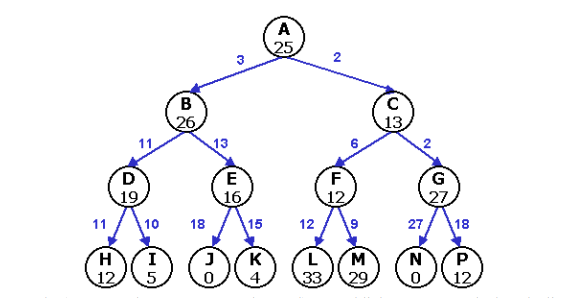
UNIVERSITY EXAMINATIONS: 2011/2012
YEAR II EXAMINATION FOR THE BACHELOR OF SCIENCE IN
INFORMATION TECHNOLOGY
BIT 2103 PRINCIPLES OF ARTIFICIAL INTELLIGENCE
DATE: APRIL 2012 TIME: 2 HOURS
INSTRUCTIONS: Answer Question One and Any other Two Questions
QUESTION ONE
a) Using your own words, give a definition of “Artificial Intelligence” [2 Marks]
b) Briefly explain three objectives of studying artificial intelligence [3 Marks]
c) Translate the following sentences into predicate logic.
i) No one likes brussel sprouts [2 Marks]
ii)John likes everyone who is tall. [2 Marks]
d) Give three limitations of using rules as a technique for representing knowledge. [3 Marks]
e) Answer the following questions by indicating whether the statements are True (T) or False (F).
[4 Marks]
1. “Two primary school children, Dennis and Sarut are playing the Tic-tac-toe game. Dennis
makes the first move (starts the game).”The minimum number of moves Sarut could make is 2
for Dennis to win the game.
2. Depth-first search is often slower than Breadth-first search.
3. Draughts (checkers) and Scrabble are both deterministic games.
4. A rational intelligent agent acts in such a way as to minimize its expected value of performance
measure given the percept sequence to date.
f) Consider the search tree shown below where each circle represents a node corresponding to a state
in the search space. The estimated cost (i.e. h function) for finding a solution from a node is
shown in its circle. The two nodes with h = 0 are goal states and the other terminal nodes are deadends. (I.e. states that can never reach a goal). Actual link costs are marked on the links between the
nodes. Thus the path cost (i.e. g function) of a node is equal to the sum of the link costs from the
root to that node.

i) Using the depth-first search algorithm, give the path to goal state. What is the path cost?
[4 Marks]
ii)Using the greedy search algorithm to find the path to goal state .what is its path cost? [3 Marks]
g) Show the truth value of the following propositional calculus sentences [3 Marks]
I. (¬P ∧ Q ) ∨ R ; where P and R have truth value F, and Q has truth value T
II. ¬(P ∧ Q) ∨ (¬P ∧ R) ; where P, Q and R have truth value T
h) Describe the meaning of the term “inference engine ” [2 Marks]
i) State and explain any two knowledge representation schemes. Give an example for each case
[4 Marks]
QUESTION TWO
a) Explain the meaning of the following terms [6 Marks]
i) Intrapersonal intelligence
ii)Forward chaining
iii) Backward chaining
b) State and explain five elements of defining a search problem in artificial intelligence. [5 Marks]
c) Explain one application of artificial intelligence business enterprises Give one example [3 Marks]
d) Consider the MIN-MAX game tree given below. (To answer this question you will have to draw
two neat sketches of the tree on your answer sheet)
i.) Fill in the utility function values at each node (the blank circles) in the MIN-MAX tree below, and
mark the first move path, from the root node (initial state) with a thick line. [2 Marks]

ii.) Cross out the branches that are pruned by α-β pruning. How many nodes did you not have to visit
with α-β pruning (count the leaf nodes as well)? Show all intermediate values at each node as they
get updated. [4 Marks]
QUESTION THREE
a) Explain the meaning of the term “knowledge representation”. [2Marks]
b) Briefly explain two assumptions of knowledge representation. Give one example for each
assumption [4Marks]
c) State and explain any three methods of acquiring knowledge [3 Marks]

d) Use the following two figures of an 8 tile puzzle game. to define its search problem [7 Marks]
e) State and explain four types of board games in the context of game theory [4 Marks]
QUESTION FOUR
a) Outline four differences between an agent and other software. [4 Marks]
b) State and explain four types of agent’s environments [4 Marks]
c) Briefly explain two types of mobile agents. Give one example for each type [2Marks]
d) Describe the two principles of The Alpha-Beta values that are used during pruning in min max
algorithm [2 Marks]
e) you are given an expert system with several rules pertaining to the interpersonal skills of a job
applicant
R1: if the applicant answers questions in straight forward manner then she is easy to converse with
R2: If the applicant seems honest then she answers in straight forward manner.
R3: If the applicant has item on her resume that are found to be untrue then she does not have
honest.
R4: If the applicant is able to arrange an appointment with the executive assistant then she is able
to strike up a conversation with the executive assistant.
R5: IF the applicant strikes up a conversation with the executive assistant and the applicant is easy
to converse with then she is amiable.
R6: If the applicant has adequate interpersonal skills. Then we will offer her the job.
Solve the following problems:
i) Assume that the applicant does not have any items or her resume that are found to be untrue and
that she is able to arrange an appointment with the executive assistant. Run a forward chain
analysis to find out whether we will offer her a job. [2 Marks]
ii)It is known that the applicant answers questions in straight forward manner. Run backward chain
analysis to find out whether we will offer a job to the applicant. [2 Marks]
iii) We have just discovered that the applicant was able to arrange an appointment with the
executive assistant. It is also known that she is honest. Doest she have interpersonal skills?
[2 Marks]
f) Briefly explain the meaning of the term “Intelligent agent” [2 Marks]
QUESTION FIVE
a) Describe the meaning of the term ‘expert system’ in the context of artificial intelligence [2 Marks]
b) Outline any four benefits of implementing explanation facility in expert systems? [4 Marks]
c) Use examples to describe any three applications of expert systems [3 Marks]
d) Draw a well labled structure of an expert system. [4 Marks]
e) Explain the function of each part of an expert system drawn in (d) [7 Marks]